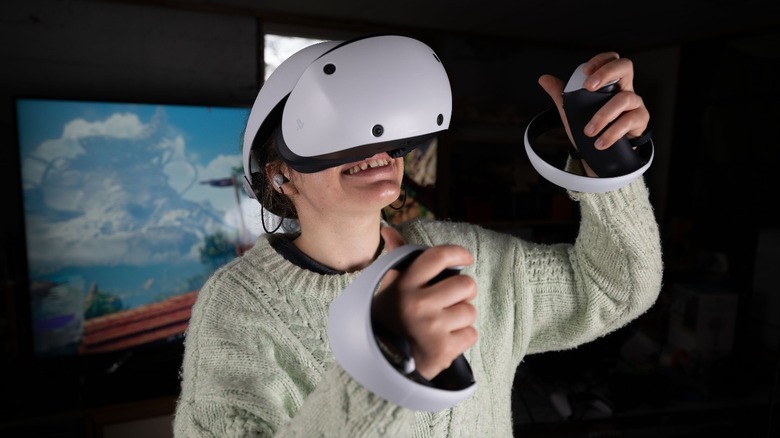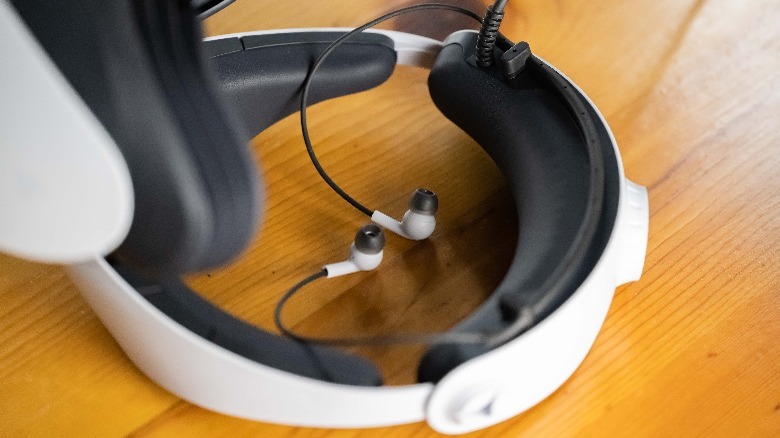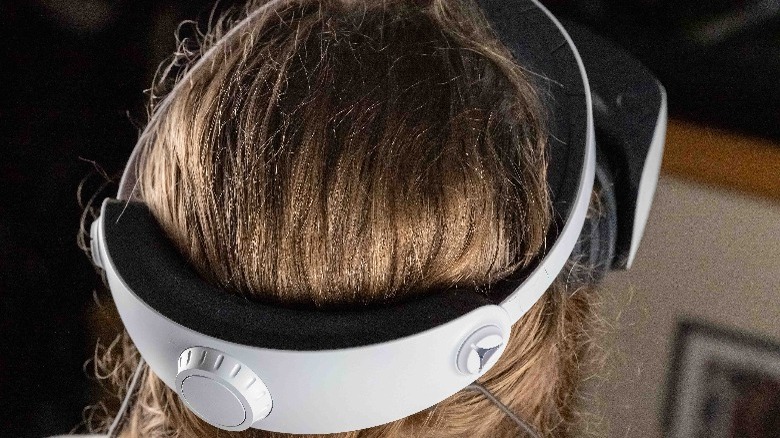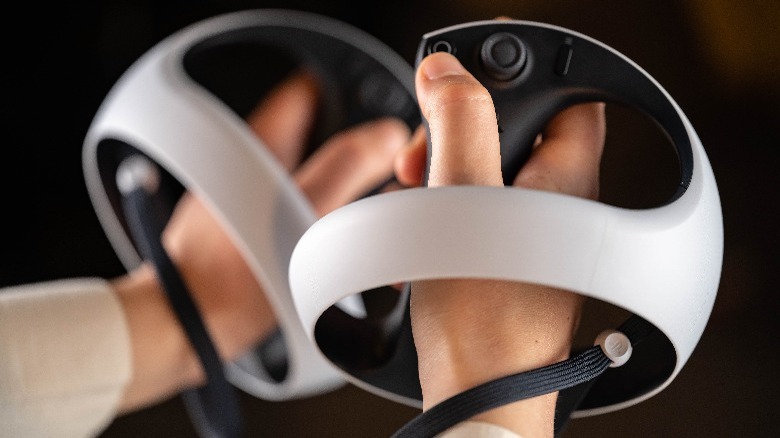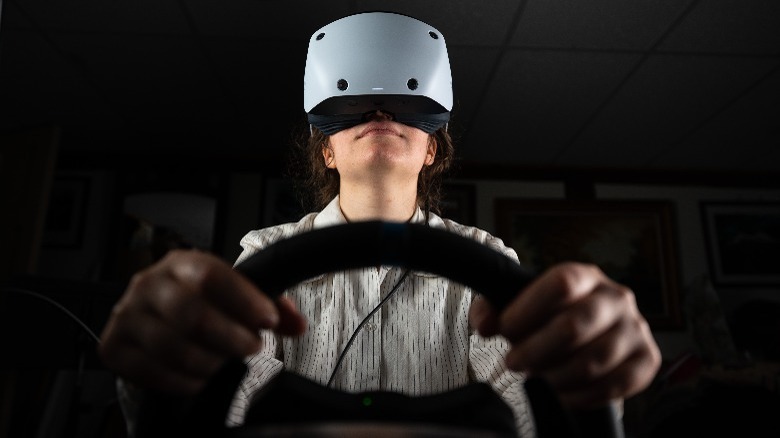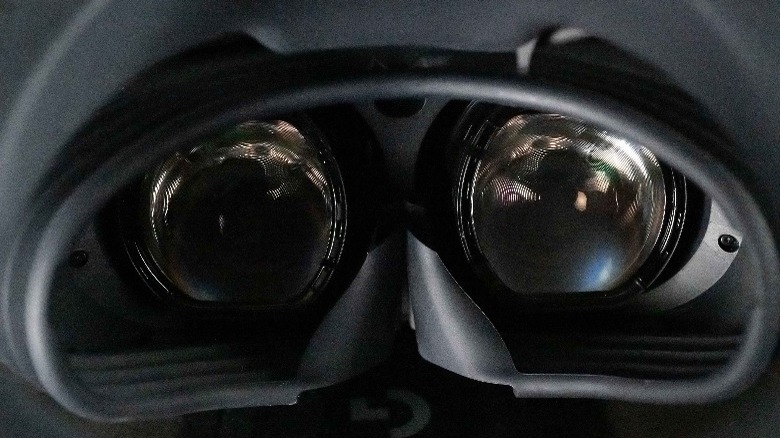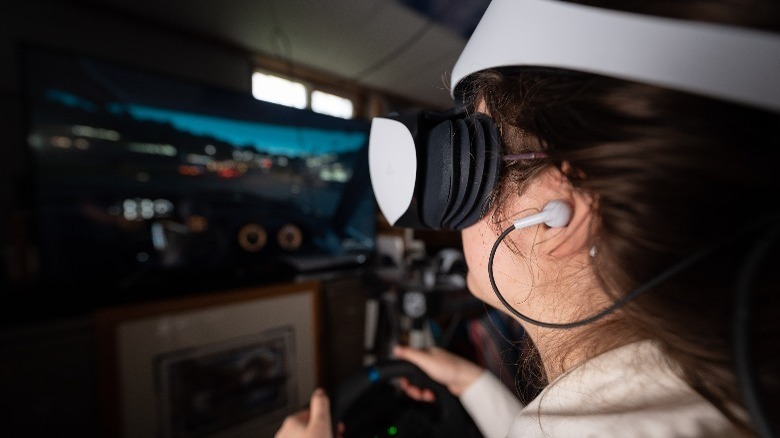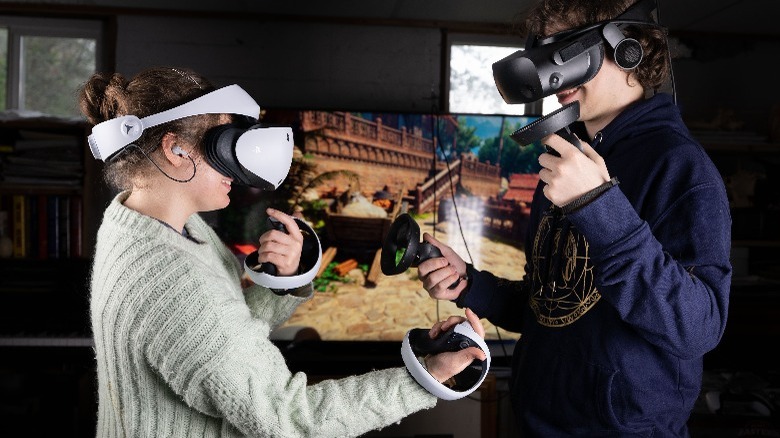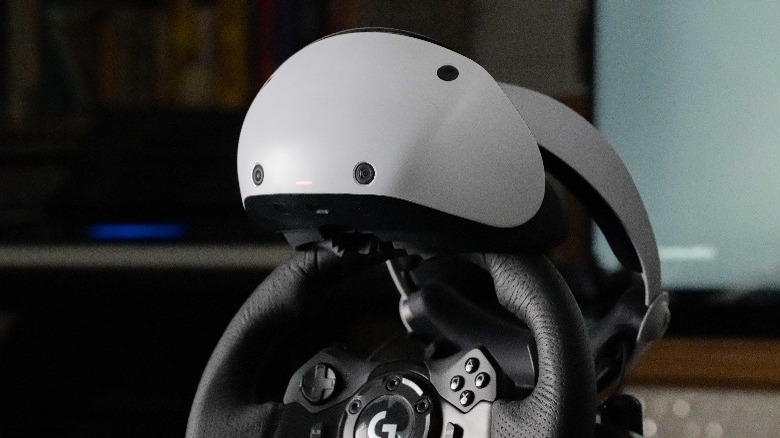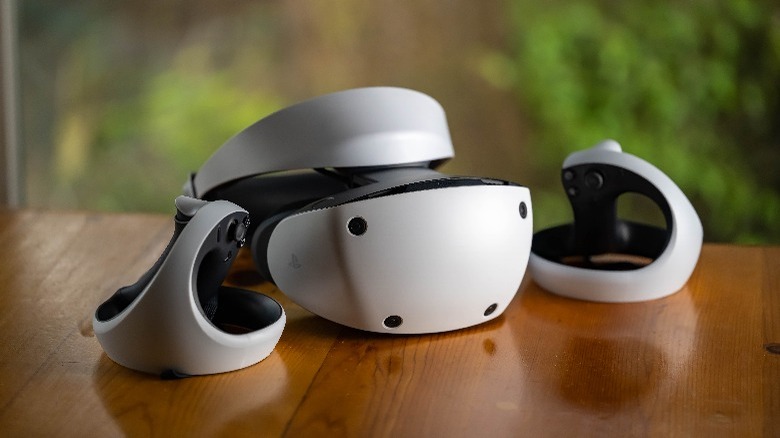PlayStation VR2 Review: Is This PSVR Headset Worth Its Price Long-Term?
- OLED displays are crisp and vibrant
- Foveated rendering augments PS5 graphical capabilities
- Wide field of view
- Exclusive games are fantastic
- Uses a single cable with no breakout box
- Comfortable to wear for long periods of time
- May suffer from long-term durability issues
- Controllers are a bit cramped for big hands
- Somewhat limited game lineup, even weeks after launch
- Moire is occasionally distracting
We may receive a commission on purchases made from links.
Virtual reality has come a long way in the past decade, but while many great standalone and PC headsets exist, only Sony offers one designed exclusively for consoles and specifically for playing video games. The PlayStation VR2 (also known as PS VR2) is the second generation of Sony's gaming-focused virtual reality (VR) headsets, and it comes with huge upgrades over its predecessor. It's so good (on paper at least), that it's enough to make owners of high-end PC VR headsets jealous.
While there are a lot of cool new features to drool over in the PS VR2, which we will dive into shortly, the most exciting and important aspect is arguably eye tracking. This feature elevates the headset, and indeed the PlayStation 5 itself, to compete with the graphical capabilities of gaming PCs several times the price of the PS5.
I purchased the PlayStation VR2, along with games and accessories, on the day it launched. In addition to the PS VR2 bundle with "Horizon: Call of the Mountain", I picked up Gran Turismo 7 and a Logitech G923 racing wheel with pedals and gear shifter, as well as the cheapest compatible stand I could find on Amazon (I had to save a few pennies somewhere). Perhaps I went a little overboard, but I was genuinely excited about the PS VR2 and wanted to experience the best of what it had to offer.
A better VR setup experience
The last VR headset I set up personally was an HP Reverb G2, and getting it working with a PC was a considerable challenge. It involved a lot of tinkering, a breakout box with many different cables, and somewhat glitchy software that still gives me grief to this day. The Reverb G2 is great, but it's also a pain in the neck. Even the original PlayStation VR was afflicted with a breakout box and the resulting medusoid tangle of cables.
The PS VR2 tames that wire hydra that so afflicted older consoles by only saddling you with a single USB-C cable, making the whole thing much easier to manage. It's quite literally a plug-and-play experience, and from there, it's very straightforward. Simply power on the headset and included Sense controllers, and the system will guide you through a brief setup process. This includes scanning the room so that the headset can create your play area. It does this automatically, though you can manually adjust the play area. The only aspect which presented any difficulty was getting used to the fit adjustment controls, though with practice the way they function eventually made a lot of sense and improved the user experience.
The simplicity of setup is a proud feather for the PS VR2 to stick in its cap. It's something that makes this headset easier to get into for anyone who has yet to dip their eyeballs into virtual reality.
Long lasting comfort
The feel of the material used in the PlayStation VR2 was a surprise when it was first pulled out of the box. While the hard plastic surfaces are of a fairly standard material, the padding is very unusual. This feels rubbery and thin to the touch, and it's questionable how durable it will be in the long run. However, after weeks (and months) of regular use, there were no detectable, serious signs of wear, so perhaps it's tougher than it looks and feels. Durability aside, it's very comfortable, and doesn't feel fatiguing even after lengthy gameplay sessions.
In terms of adjustment options, the headset has several mechanisms to help you achieve a proper fit. First, there's the headband, which features a button with a dial running around its rim. Press the button to loosen the headband, and crank the dial to tighten it back down. Depressing a button on the visor of the headset allows you to adjust how close it is to your face. To adjust IPD, turn a little wheel on the top of the headset, and if needed, eye tracking can help you achieve the perfect IPD setting.
I do recommend also purchasing a cable management system so that you're not dragging the PS VR2 cable behind you. I've been using a system of hooks and pulleys made by KIWI designs, which attach to the ceiling via suction cups and suspend the cable overhead.
Accurate tracking and force feedback
While an inside-out tracking system such as that found in the PlayStation VR2 is inherently less accurate than one which uses base stations placed around the room, inside-out tracking nonetheless has its advantages. Using an array of cameras on the exterior of the PS VR2, the headset can see the environment around it and track your controllers. This means that the device is simpler and cheaper than it would otherwise be. Though it's not the best VR tracking system out there, the PS VR2 nonetheless provides an excellent experience in this regard. There isn't any noticeable latency, and the system never felt like it was impeding the experience.
The exterior cameras also enable you to see the room around you without removing the headset. By pressing a button on the underside of the headset you can see a black-and-white view outside, which is good enough that you'll be able to move around the room and even check messages on your phone. It's very useful if you need to talk to someone, but don't want to fully remove the headset.
The PlayStation VR2 is also equipped with haptic feedback in both the Sense controllers and the headset itself. This works well to further heighten immersion, and the implementation is subtle, yet effective.
A limited game library with some great titles
First the bad news: the PS VR2 is only compatible with older PS VR games which have been updated to support the new headset. This means that at launch its library is somewhat limited, and if you already own some VR games for the original PS VR they may not work with the PS VR2 yet (if ever). Furthermore, the current list of PS VR2 releases for the remainder of 2023 looks pretty sparse. The PS VR2 would have been much more compelling if Sony had built backward compatibility into it rather than requiring developers to patch their games to work with it.
With all that said, what is available is highly attractive and could occupy you for quite some time, particularly if "Gran Turismo 7", "Horizon: Call of the Mountain", and "Resident Evil Village" are up your alley. Games like "Gran Turismo 7" and "Call of the Mountain" are fantastic enough experiences on their own that either one can make the PS VR2 feel like a satisfying purchase.
"Gran Turismo 7" is truly gorgeous and immersive in virtual reality, particularly if you also invest in a steering wheel and pedals. The car models are incredibly detailed and accurate, as are the environments through which you drive. "Call of the Mountain" is surprisingly gorgeous, and dangling over enormous canyons as you climb and jump your way up stony cliffs will certainly raise your heart rate.
Awesome OLED
The 2000 x 2040 pixel OLED panels in the PS VR2 are a spectacular medium through which to experience virtual worlds. Colors are rich and vibrant with deep blacks and bright highlights for high contrast. Additionally, the refresh rate goes up to 120hz, which is a huge benefit to virtual reality experiences. The 110-degree field of view is another big step up from the original PS VR, and overall the visual quality of the PS VR2 is competitive with even the best PC headsets available today.
There's only one thing to mar the otherwise impeccable experience here, and that's the presence of moire patterns that may occasionally be seen floating like a ghostly curtain in your vision. This smearing is a side effect of the optical composition of the PS VR2, but while it can occasionally be distracting, it was only noticeable infrequently. The headset can also be a little blurry if you don't have it adjusted quite right, so if it isn't sharp you need to tweak the adjustments. My large, ungainly noggin and copious quantities of unruly hair make this particularly troublesome.
With that said, the PS VR2 certainly punches above its own bracket thanks to the foveated rendering enabled by the inclusion of eye tracking. By only fully rendering the tiny portion of the screen directly in front of your eyes, the PS VR2 is able to handle much higher fidelity than the PS5 could otherwise display if it were to fully render the entire screen.
Audio is a mixed bag
I'm very conflicted when it comes to how the PS VR2 handles audio. The headset includes removable earbuds designed specifically for the headset, and these are very well integrated. The sound quality isn't particularly fantastic, but it's good enough that there's no reason to complain. The passive noise cancellation is good enough that people often have to tap you on the shoulder to get your attention (with predictably hilarious reactions). They do a good job of immersing you in the VR experience. If you don't like the included earbuds, the PS VR2 has a standard 3.5mm headphone port, so whatever wired earbuds or headphones you want to use with it will work, though the custom headphones that came with the system are preferable as they don't leave excess cable to deal with.
However, coming from the HP Reverb G2, I can't help but miss the unique headphones integrated into that system which produce great sound quality and have good noise cancellation, despite being suspended over your ears without pads or anything. Not having anything in or on your ear really heightens VR immersion, and they make the headset more hygienic to share with friends and family. They weren't without problems, however, as they have a tendency to wiggle loose from the HP Reverb G2 over time. Despite that, it still feels as though it would have been better if Sony had implemented something similar in the PS VR2.
The gaming PC in the room
When assessing the PS VR2, it's impossible not to compare it to VR on PC, and the question of whether or not the PS VR2 will work with a PC must be answered. On the first point, the PS VR2 is as good or better than VR headsets within its price bracket designed for the PC. The OLED display alone is leagues better than any headset not featuring this tech, and eye tracking allows the PS5 to render VR visuals that an equivalently powerful PC would be incapable of spitting out at a decent framerate. Between this and the excellent design of the headset, it may be enough to tempt PC gamers to the PS5, particularly those without a really powerful VR-capable gaming rig.
As for whether the PS VR2 can be hooked up to a PC, the answer right now is technically yes, but only in the most simplistic way possible. The PS VR2 controllers lack the drivers they need to communicate with a PC, and the headset can only function as a screen rather than the VR headset that it is. However, it's important to note that enthusiasts did eventually get the original PS VR running on PC, though the added complexities of the PS VR2 make this a bit of a long shot. It's a possibility, but don't hold your breath.
Future prospects of VR on PlayStation
When thinking about investing in a new device such as the PS VR2, a common concern is how long the manufacturer will support it. This is largely dictated by the sales performance of the product. For this reason, it was alarming to see headlines popping up after its initial launch about how the PS VR2 had not performed as well as expected. However, it's important to look beyond the dire, clickbait titles and examine the numbers. In its first month, the PS VR2 sold around 300,000 units, which does look bad when Sony's reported goal was 2 million units within the launch window.
However, when we compare sales of PS VR2 to the original PS VR, it becomes clear that the PS VR2 is selling at a much higher rate than its predecessor, which took six months to reach 915,000 units sold. The original PS VR was also sold for the PS4 during that console's heyday when the install base of the PS4 was far larger than that currently enjoyed by the PS5. It's telling to look at attach rate: the PS VR1 was owned by 0.15% of PS4 owners after five months of sales, whereas the PS VR2 is already owned by around 0.1% after only about a month of sales.
With this in mind, Sony should count the PS VR2 as a respectable success, and there's no reason for support of the platform to decline so long as sales numbers remain stable.
Wrap-up and value proposition
Starting at $549.99, and going up to $599.99 if you want "Horizon: Call of the Mountain" bundled with it at a slight discount, the PlayStation VR2 isn't cheap. Plus, if you want the charging station for the controllers that's another $49.99. However, if we compare it to similar PC headsets such as the HP Reverb G2, which is available for roughly the same price, we see that the PlayStation VR2 actually delivers good value for money, given how impressive the headset is.
Also, paired with the $399.99 PlayStation 5 Digital Edition and "Horizon: Call of the Mountain", the total cost only adds up to $1000. By comparison, the HP Reverb G2 goes for just $453.20 on Amazon, but you'd need to spend at least $1000 for a gaming PC capable of rivaling the PlayStation VR2 experience. With that in mind, the PS VR2 is actually a bargain by comparison.
The bottom line is that despite these nitpicks, the PlayStation VR2 is easy to recommend. It's particularly compelling for console gamers, and for people who want to get into VR but don't already own a powerful gaming PC. The exclusive games are good enough that even for someone with a powerful gaming PC and a good VR headset, purchasing the PS VR2 is nonetheless a decision you're unlikely to regret.
